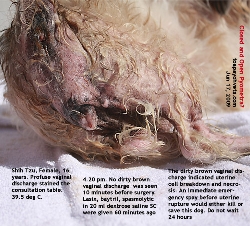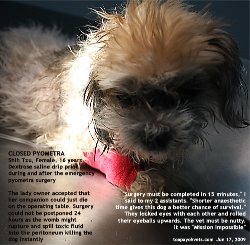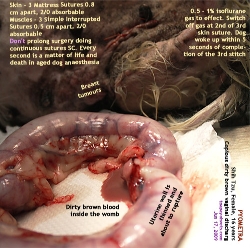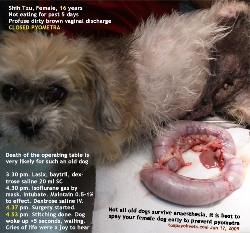 "The surgery must be completed in 15
minutes if the dog is to survive," I
said to my two assistants. They
looked at each other and grinned,
looking skywards. It was just not
possible and I must be a nutty
veterinary surgeon.
"The surgery must be completed in 15
minutes if the dog is to survive," I
said to my two assistants. They
looked at each other and grinned,
looking skywards. It was just not
possible and I must be a nutty
veterinary surgeon.
This 16-year-old dog had not been
eating for 5 days. Dark coloured
vaginal discharge in large amounts.
Was this the end of her life?
Without emergency surgery to remove
her infected womb, she would die.
She might die if she was operated.
"Please wait," the best friend said
to me as the lady owner made some
phone calls outside the surgery. Her
eyes were red. 16 years in a dog
would be equivalent to over 100
years old in a person. Too old to
survive an operation. The lady
finally consented to the surgery and
knew that it could be the last
goodbye when I asked her to go home.
However, if the operation
could be performed in 5
minutes, she might survive.
But pyometra surgery would
take more than 5 minutes. The
shorter the anaesthesia, the
higher the chances of
survival. How to do it? Was it
a Mission Impossible?
 Pre-operation
Pre-operation
1. 20 ml dextrose saline with
baytril, lasix and spasmogesic
injections were given 1 hour ago.
Her temperature was 39.5 degrees C,
pulse was strong and respiratory
rate was normal.
2. I/V dextrose saline drip given
after preparing and shaving the
operation site.
Anaesthesia
Isoflurane gas by mask, intubate,
gas at 0.5 to 1% to effect. My
assistant, Mr Saw was now much more
experienced in assessing the depth
of anaesthesia. I noted that the
blood during my surgery was bright
red instead of bluish and so I knew
he was doing a good job. It was
great surgical anaesthesia. "Keep
lowering the % till the dog react" I
advised him to check for pedal pain
and eye blinking reflexes. Only
during the end of surgery did the
dog move a bit. Mr Saw increased the
% to 5% but I told him that 2% would
do.
Surgery
"More haste less speed" seemed to be
presented when I incised the linea
alba, the midline fibrous tissue
connecting two halves of the
abdominal muscles. I incised but
found that the muscles did not
separate. I saw the brown muscle
fibres instead. The linea alba was
faint in this region and my incision
missed it by 4 mm. "Look further
cranial," my second assistant
advised me as he saw me looking for
the linea alba which was faint at
this area, around 6 cm from the
umbilical area. I checked anteriorly
and followed the direction of the
linea alba backwards. Got it.
The muscles separated. I put my
gloved finger into the abdomen. The
small and large intestines were
blocking my view. A few seconds
passed. I hooked out the swollen
uterine tubes.
Ligated the ovarian tissues. Then
the uterine body. Time was passing
by fast. The dog had not given me
cause to worry as the bright red
blood indicated that she had
sufficient oxygenated blood and her
heart was beating normally under
general anaesthesia. Still I could
not be complacent or slow. Anytime
the heart could just stop beating
and a dead dog would be presented.

After getting rid of the uterus, I
quickly put 3 simple interrupted
sutures at 0.8 cm apart to close the
muscles. No fanciful subcutaneous
sutures as this would take more
time. I just stitched up the skin
with 3 horizontal mattress sutures.
"Switch off the anaesthesia," I said
to Mr Saw. He had already reduced
the gas to 0.5% and the dog was
still anaesthesized. This showed
that the dog was very weak as normal
dogs would need 2% to be knocked
out. "Switch off," I said as I tied
the 2nd of 3 skin stitches. Mr Saw
did it. I completed the 3rd stitch.
The dog just woke up suddenly.
"Take out the endotracheal tube," I
said to Mr Saw who had by then,
untied the four legs. "Put the dog's
head to the side in case she
vomits."
The dog just looked as if she had a
nap. She wailed and wailed. This
happened sometimes after isoflurane
gas anaesthesia without any other
tranquilisation or sedation. Why
would a 16-year-old dog wail and
wail, I cannot say. Neither do I
receive many case of such very old dogs with
pyometra. I thought the old female dogs had menopaused and would never get
pyometra. This case proved me to be
mistaken.
But such loud wailings were good
signs of a dog being much alive at
the end of surgery and were a joy to
hear. Sleeping dogs that don't wail
at the end of surgery would be dead.
So, you could understand why I
enjoyed hearing this old cougar
wailing. Well, she was not really
the "old cougar" as the term refers
to a lady marrying a much young man.
"What time is it?" I asked Mr Saw as
I completed my last stitch. "4.55
pm," he said. He was at the far end
to my left and opposite me at the
other side of the operating table,
nearer to the isoflurane vaporiser.
I looked at the clock, just above
the door of the operating room and
to my right. "It is 4.53 pm" I
was facing the clock directly and so
could see the correct time. I had used 16
minutes to perform the surgery. It
was really Mission Impossible as my
key performance indicator was 15
minutes.
 The naughty
Shih Tzu was alert
but refused to eat. Well, what do I
expect? She had just completed a
major surgery. Her temperature
dropped to 36 deg C one hour after
surgery. She had the IV drip but I
was worried. I phoned her owner. She
could still die despite a successful
surgery if she did not eat. She
could be suffering from
hypoglycaemia (low blood sugar).
The naughty
Shih Tzu was alert
but refused to eat. Well, what do I
expect? She had just completed a
major surgery. Her temperature
dropped to 36 deg C one hour after
surgery. She had the IV drip but I
was worried. I phoned her owner. She
could still die despite a successful
surgery if she did not eat. She
could be suffering from
hypoglycaemia (low blood sugar).
I phoned the lady owner to get the
dog home to nurse. This would be a
finicky dog and would not eat unless
hand fed. The best friend had a car
and her gentleman friend and the
owner went home with the dog. Some
two hours
later, the owner, "My dog
passed blood. Is it normal?"
"Yes," I said. "The blood is from
the vestibule of the vagina." I
doubted that the lady knew what
vestibule was about. In any case,
she said that the dog ate and
everything was OK.
BE KIND TO PETS
It is best to get your female dog
spayed young when she is healthy.
Pyometra is sometimes missed and
anaesthesia in very old dogs is
usually very risky. Not all
aged dogs recover from anaesthesia
as in this case.
 TOA
PAYOH VETS
TOA
PAYOH VETS TOA
PAYOH VETS
TOA
PAYOH VETS